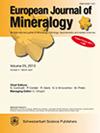Depth profile analyses by femtosecond laser ablation (multicollector) inductively coupled plasma mass spectrometry for resolving chemical and isotopic gradients in minerals
IF 1.7
3区 地球科学
Q2 MINERALOGY
引用次数: 0
Abstract
Abstract. Femtosecond laser ablation (fs-LA) coupled to a multicollector inductively coupled plasma mass spectrometry (MC-ICP-MS) instrument has been proven to be a powerful means to analyze isotope ratios of “non-traditional” stable isotope systems with high spatial resolution, precision, and accuracy. The technique has been successfully applied, e.g., to investigate diffusion-generated isotopic zoning of the elements Li, Mg, and Fe in magmatic crystals. Here, we present a novel sampling technique employing a fs-LA system that is equipped with a computer numerical control (CNC) laser stage, using the open-source software LinuxCNC. Combining this laser set up with ICP-MS or MC-ICP-MS allows us to perform depth profile analyses of major and trace elements, respectively, as well as metal stable isotope variations of Fe and Mg in olivine crystals and in experimental diffusion couples. Samples are ablated in circular patterns with profile diameters of 100–200 µm using a laser spot size of 25–30 µm. Depending on the scan speed and the repetition rate of the laser, each ablated sample layer is between 300 nm and 3.0 µm thick. The integrated signal of one ablated layer represents one data point of the depth profile. We have tested this technique by analyzing 5–50 µm deep depth profiles (consisting of 15–25 individual layers) of homogeneous and chemically zoned olivine crystal cuboids. The minor and trace element analyses of the zoned cuboids, conducted by fs-LA-ICP-MS, were compared with “horizontal” profiles analyzed in polished sections of the cuboids with electron probe microanalysis (EPMA). Furthermore, we analyzed Fe–Mg isotopic depth profiles of the same cuboids with fs-LA-MC-ICP-MS, of which the chemically zoned ones also showed isotopic zoning at identical scales. Isotopic depth profiles were also conducted on an unzoned olivine cuboid that was coated with a 26Mg- and 56Fe-enriched olivine thin film (of ∼ 800 nm) in order to investigate top-to-bottom contamination during depth profiling. Our results indicate that (i) concentration data acquired by fs-LA depth profiling match well with EPMA data, (ii) precise and accurate Fe and Mg isotopic data can be obtained (i.e., precision and accuracy are ≤ 0.12 ‰ and ≤ 0.15 ‰ for both δ26Mg and δ56Fe, respectively), and (iii) potential top-to-bottom contamination during depth profiling of isotope ratios can be avoided. The technique presented herein is particularly suitable for the investigation of minerals or glasses with chemical and/or isotopic gradients (e.g., diffusion zoning) vertical to planar surfaces. It can also be applied in materials sciences in order to analyze thin films, coatings, or surface contaminations on solids.用飞秒激光烧蚀(多收集器)电感耦合等离子体质谱法分析矿物中的化学和同位素梯度
摘要飞秒激光烧蚀(fs-LA)耦合多收集器电感耦合等离子体质谱(MC-ICP-MS)仪器已被证明是一种分析“非传统”稳定同位素系统同位素比率的强大手段,具有高空间分辨率、精度和准确度。该技术已被成功地应用于研究岩浆晶体中Li、Mg和Fe元素的扩散产生的同位素分带。在这里,我们提出了一种新的采样技术,采用fs-LA系统,配备了计算机数控(CNC)激光台,使用开源软件LinuxCNC。将这种激光装置与ICP-MS或MC-ICP-MS相结合,使我们能够分别对主要和微量元素进行深度剖面分析,以及橄榄石晶体和实验扩散对中Fe和Mg的金属稳定同位素变化。样品被烧蚀成轮廓直径为100-200µm的圆形图案,激光光斑尺寸为25-30µm。根据激光的扫描速度和重复频率,每个烧蚀样品层的厚度在300 nm到3.0µm之间。一个烧蚀层的综合信号代表深度剖面的一个数据点。我们通过分析5-50 μ m深度剖面(由15-25个单独的层组成)的均匀和化学带橄榄石晶体长方体来测试该技术。用fs-LA-ICP-MS对带状长方体的微量元素和痕量元素进行了分析,并与用电子探针微量分析(EPMA)在长方体抛光部分分析的“水平”剖面进行了比较。此外,我们用fs-LA-MC-ICP-MS分析了同一长方体的Fe-Mg同位素深度剖面,其中化学分带的长方体也表现出相同尺度的同位素分带。为了研究深度剖面过程中从上到下的污染,我们还对一个无区橄榄石长方体进行了同位素深度剖面,该长方体表面涂有一层富含26Mg和56fe的橄榄石薄膜(约800 nm)。结果表明:(1)fs-LA深度剖面获得的浓度数据与EPMA数据吻合良好;(2)可以获得精确的Fe和Mg同位素数据(δ26Mg和δ56Fe的精密度和准确度分别为≤0.12‰和≤0.15‰);(3)可以避免同位素比值深度剖面的自下而上污染。本文提出的技术特别适用于具有垂直于平面表面的化学和/或同位素梯度(例如扩散带)的矿物或玻璃的研究。它也可以应用于材料科学,以分析薄膜、涂层或固体表面污染。
本文章由计算机程序翻译,如有差异,请以英文原文为准。
求助全文
约1分钟内获得全文
求助全文
来源期刊
CiteScore
2.80
自引率
9.50%
发文量
40
审稿时长
6-12 weeks
期刊介绍:
EJM was founded to reach a large audience on an international scale and also for achieving closer cooperation of European countries in the publication of scientific results. The founding societies have set themselves the task of publishing a journal of the highest standard open to all scientists performing mineralogical research in the widest sense of the term, all over the world. Contributions will therefore be published primarily in English.
EJM publishes original papers, review articles and letters dealing with the mineralogical sciences s.l., primarily mineralogy, petrology, geochemistry, crystallography and ore deposits, but also biomineralogy, environmental, applied and technical mineralogy. Nevertheless, papers in any related field, including cultural heritage, will be considered.

 求助内容:
求助内容: 应助结果提醒方式:
应助结果提醒方式:


